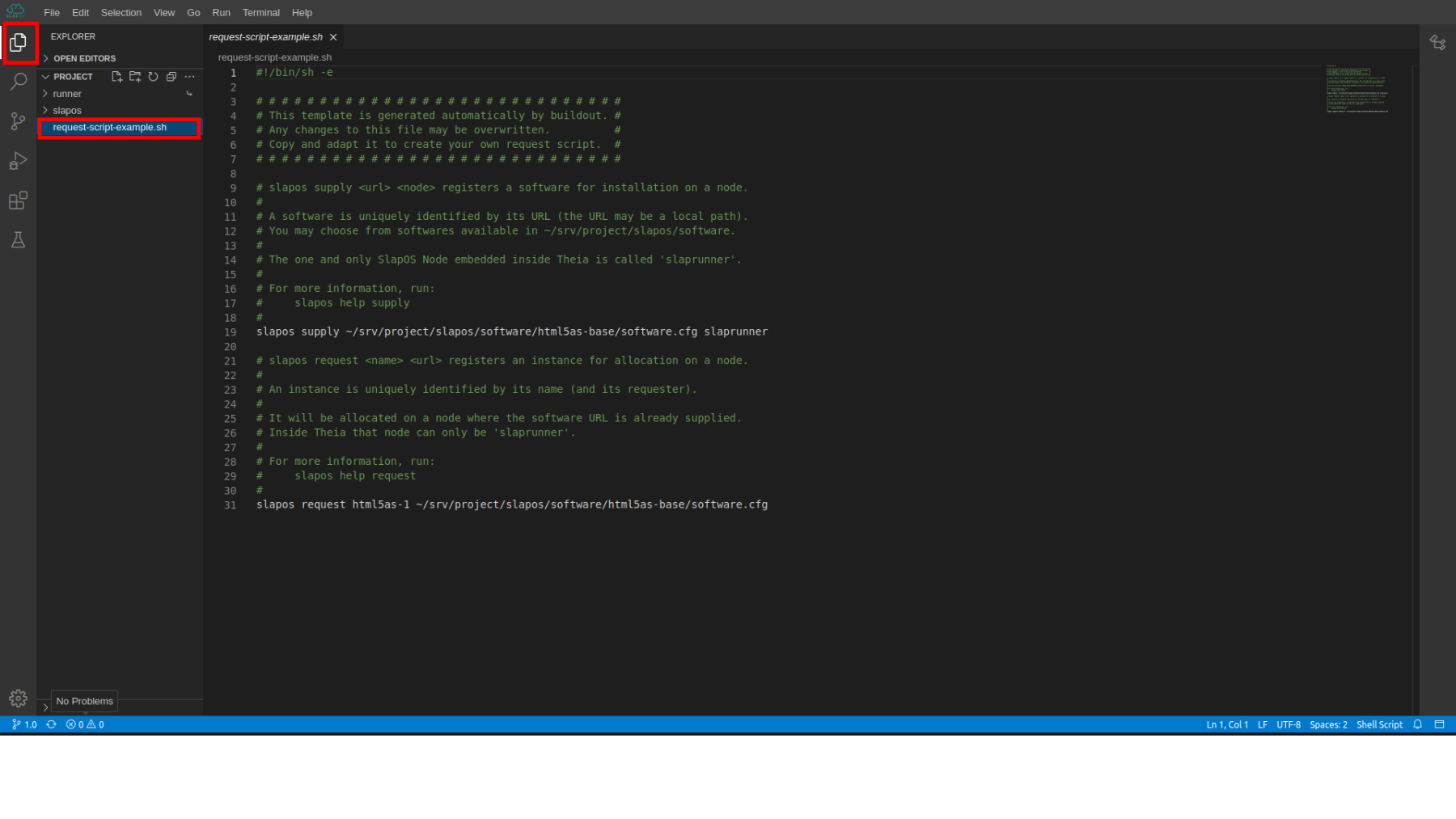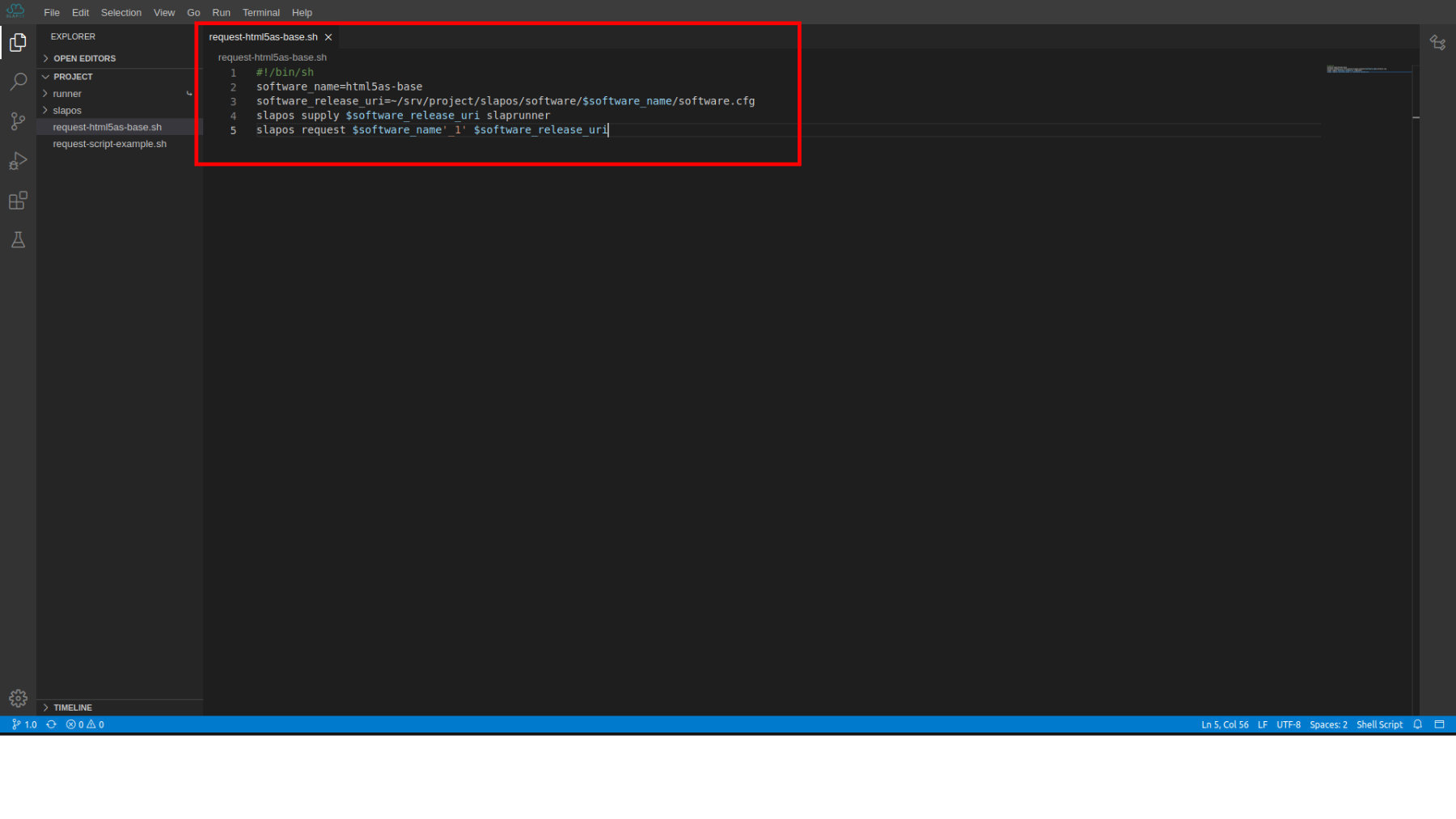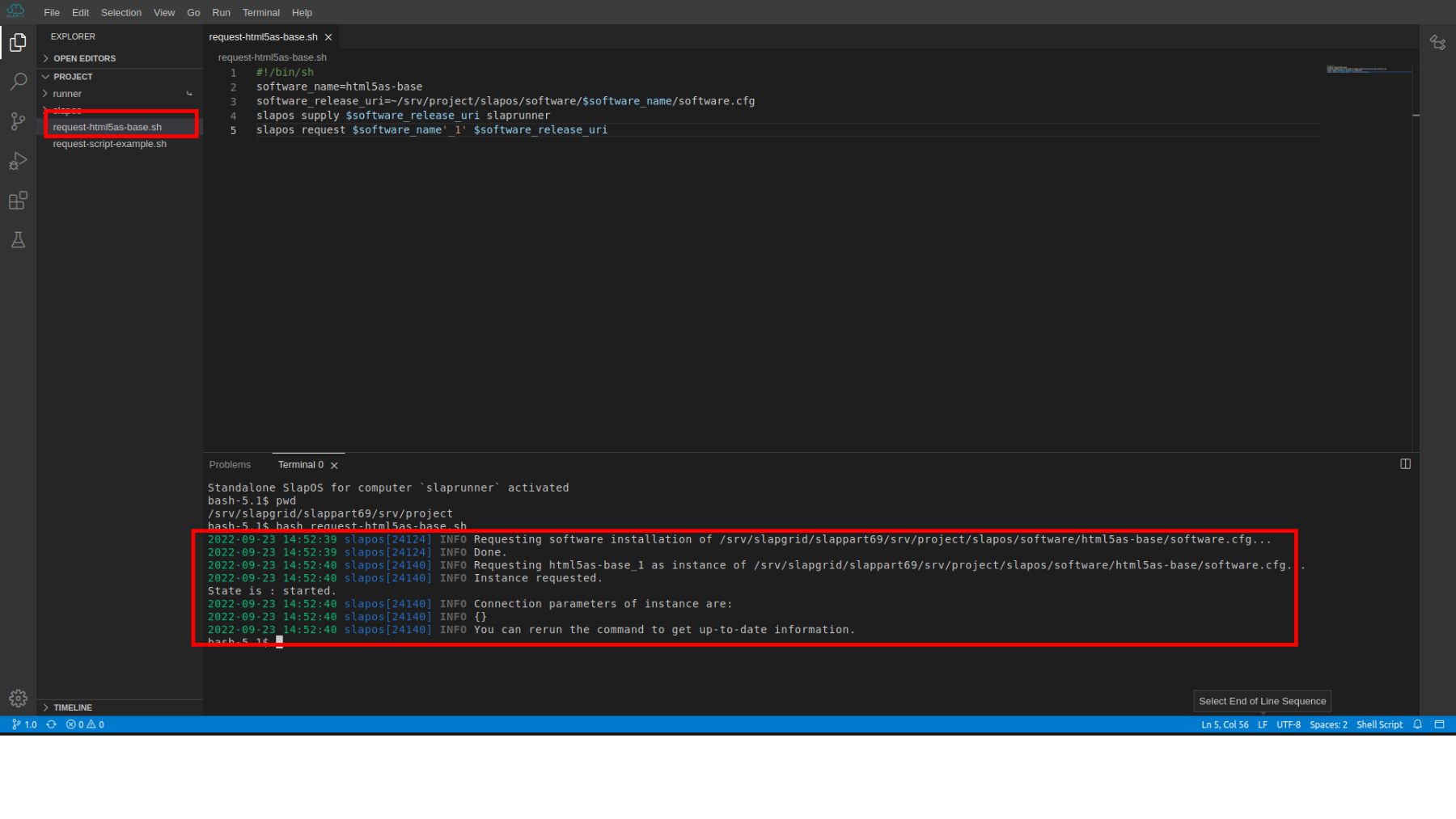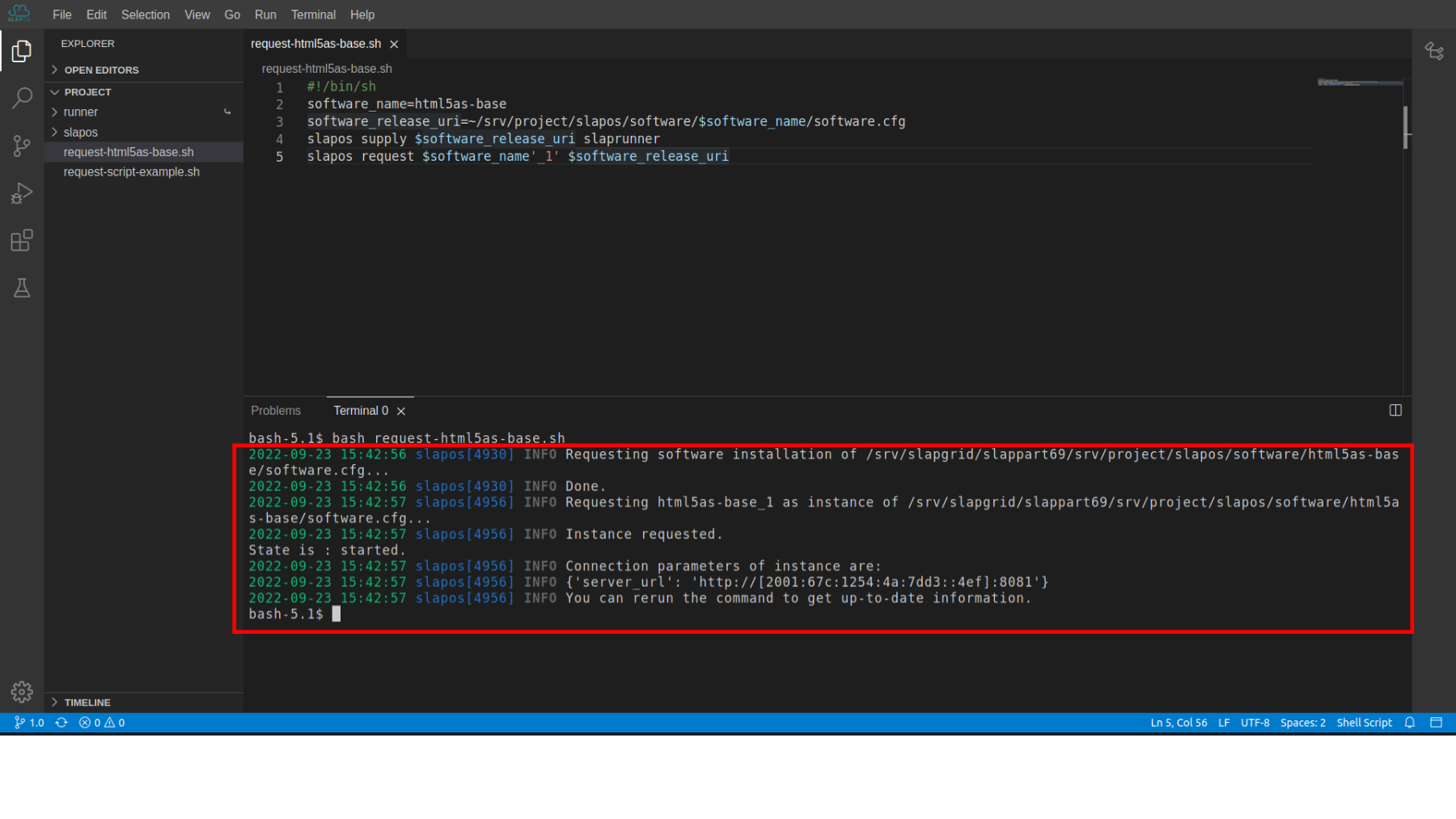Agenda
- Prerequisites
- Supplying a Software
- Request an Instance
- Use a Script to supply and request
- Verification
This tutorial will teach you how to use a useful Bash script on Theia for supplying a software and requesting an instance on Theia.
Supplying a Software
slapos supply: This command is used to add the software to the list of software to be supplied to a node.
$ slapos supply $software_release_uri slaprunner
slapos supply [software] [node]
For example, the software is html5as-base, located in ~/srv/project/slapos/software/html5as-base/software.cfg. We can set a variable named software_release_uri and the value is ~/srv/project/slapos/software/html5as-base/software.cfg.
In the case of Rapid.Space Theia, Node is the embedded node named slaprunner
When you are inside theia, you are actually talking to a slapproxy (small slapos master) dedicated to your Theia.
After supply, the master will list the software as to be supplied by the node. And on the next run of slapos node software in the node will start installing the software.
Requesting an Instance
slapos request: request the allocation of an instance to the master. This commands also get status and parameters of the instance if it has any (the command is meant to be run multiple time until you get the status).
$ slapos request $software_name'_1' $software_release_uri
slapos request "instance_name" [software]
In order to deploy a service, use slapos request to ask the master to allocate an instance for you. Since the slapproxy (small master in Theia) only knows a local node, you are sure the master will allocate the software to your local node. “instance_name” is up to you, and [software] must be exactly the same path you supplied earlier.
request is the command to:
- create the service if it’s not yet created
- get parameters from a service
Use a Script to supply and request
#!/bin/sh
software_name=html5as-base
software_release_uri=~/srv/project/slapos/software/$software_name/software.cfg
slapos supply $software_release_uri slaprunner
slapos request $software_name'_1' $software_release_uri
From terminal, we can use the command presented before to supply a software and request an instance. More documentation is available here: slapos command line.
For convenience, and to make sure you always request the proper software, it is recommended to use a script like the one presented here. Change the software_name of the software release to the one you need, which should be listed in ~/srv/project/slapos/software/
Instances are identified by their name, make sure your instance name is unique. Requesting the same instance with a different software release url is possible, it is used to update instances.
Access Theia

Locate the connection parameter on your Theia service. You can access the Theia using the url and logging in with username and password.
Locate the script file

The bash file has already listed under PROJECT directory.
Duplicate the script file

Duplicate the request script bash file and rename to request-your-software-name.sh.
Modify/Verify Script

Edit the file to suit your situation. Here, for example, we would like to deploy html5as-base. The software.cfg is located: ~/srv/project/slapos/software/html5as-base/software.cfg. So we set software_name as html5as_base so the software_release_uri will be ~/srv/project/slapos/software/html5as-base/software.cfg.
As the computer name is slaprunner, we supply $software_release_uri to slaprunner. $software_name'_1' is the name for your software's instance.
#!/bin/sh
software_name=html5as-base
software_release_uri=~/srv/project/slapos/software/$software_name/software.cfg
slapos supply $software_release_uri slaprunner
slapos request $software_name'_1' $software_release_uri
Run Script

Open a Terminal by clicking the button on the toolbar or hitting Ctrl+Shift+².
Locate the script and launch it by
bash request-html5as-base.sh
Please make sure you are launching the duplicated request script instead of the original request script. The original request script will be overwritten all the time because it is a part of the configuration of Theia.
For example, here we are at ~/srv/project, to launch request-html5as-base.sh, we need type
bash request-html5as-base.sh
Reading the output

This the output of slapos supply and slapos request.
Slapos supply ouput
2021-03-05 17:48:23 slapos[37281] INFO Requesting software installation of /srv/slapgrid/slappart73/srv/project/slapos/software/html5as-base/software.cfg...
2021-03-05 17:48:23 slapos[37281] INFO Done.
This the output of slapos supply.
Slapos request output
2021-03-05 17:48:23 slapos[37297] INFO Requesting html5as-base_1 as instance of /srv/slapgrid/slappart73/srv/project/slapos/software/html5as-base/software.cfg...
2021-03-05 17:48:23 slapos[37297] INFO Instance requested.
State is : started.
2021-03-05 17:48:23 slapos[37297] INFO Connection parameters of instance are:
2021-03-05 17:48:23 slapos[37297] INFO {}
2021-03-05 17:48:23 slapos[37297] INFO You can rerun the command to get up-to-date information.
This the output of slapos request.
As it is the first time that we launched the request script, the script is creating the service. After the instance instantiate, you can return the script to get up-to-date information. The connection parameters will be listed.
Verification
-
Compile and Instantiate
-
Verify connection parameter
You will have the connection parameters as soon as you have the instance instantiated.
Compile: slapos node software --all
slapos node software: this is the command a node is launching to actually compile/remove the softwares
You can run slapos node software in Terminal to compile the software.
slapos node software (--all) will compile the software locally in the node. The compilation directory will be used later to instantiate your service . Your instance will be deployed totally from the software installation directory (no more access to internet).
Instantiate: slapos node instance --all
slapos node instance: run instance deployment on the node
After have an instance requested, you can run slapos node instance (--all) in Terminal to instantiate your software. This is the command actually deploying the service in the node.
Verify connection parameter

You will have the connection parameters as soon as you have the instance instantiated.